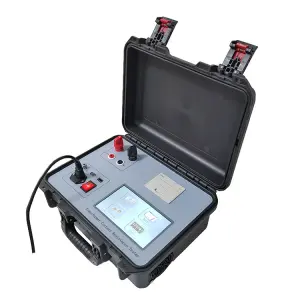If a spill occurs involving Contact resistance tester reagents, it’s important to take immediate action to minimize risks to personnel, property, and the environment.
Here are the recommended actions to take:
- Assess the Situation: Quickly assess the severity and extent of the spill. Determine the nature of the reagents involved and whether they pose any immediate hazards to health or safety.
- Alert Others: Notify nearby personnel about the spill and instruct them to avoid the area until it has been safely cleaned up.
- Put on Personal Protective Equipment (PPE): Before attempting to clean up the spill, put on appropriate PPE, including gloves, goggles, and a lab coat or protective clothing, to protect yourself from exposure to the reagents.
- Contain the Spill: If the spill is small and manageable, attempt to contain it by placing absorbent materials (such as spill pillows, pads, or absorbent powder) around the perimeter of the spill to prevent it from spreading further.
- Prevent Further Contamination: If the spill involves liquids, use spill barriers (such as sandbags or absorbent socks) to prevent the reagents from spreading to other areas. Avoid walking through the spill to prevent tracking it to other locations.
- Ventilate the Area: Open windows or doors to allow for natural ventilation and airflow to help dissipate any fumes or vapors emitted by the spilled reagents. Use fans or ventilation systems if available to further facilitate air exchange.
- Clean Up the Spill: Carefully clean up the spill using appropriate procedures and materials. Use absorbent pads or towels to soak up liquids, and dispose of them in accordance with local regulations for hazardous waste disposal. For solid spills, use a brush and dustpan to collect the material, taking care to avoid generating dust.
- Decontaminate Surfaces: Once the bulk of the spill has been cleaned up, decontaminate surfaces in the spill area using a suitable disinfectant or cleaning solution. Follow manufacturer instructions for proper dilution and application.
- Dispose of Contaminated Materials: Dispose of all contaminated materials, including absorbent pads, towels, and cleaning supplies, in accordance with local regulations for hazardous waste disposal. Use designated waste containers and label them appropriately.
- Document the Incident: Record details of the spill, including the date, time, location, and materials involved. Document any actions taken to clean up the spill and any injuries or exposures that occurred as a result.
- Review and Learn: Conduct a post-incident review to identify the root causes of the spill and any corrective actions that can be taken to prevent similar incidents in the future. Update procedures, training, or equipment as needed to improve safety and prevent spills from occurring again.
By following these steps, organizations can effectively respond to spills involving Contact resistance tester reagents, mitigating risks and minimizing the impact on personnel and the environment.
